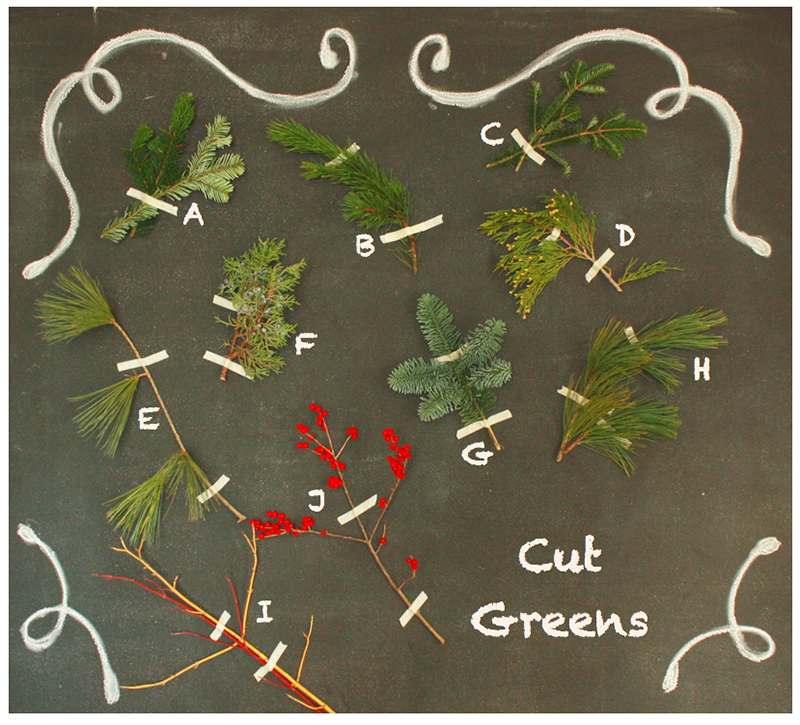Hold on tight for a crash course in wintergreens! Take notes because their might be a test on your own mantle this holiday season…

A) Silver fir: Cut from some of the very first Christmas trees, silver fir boasts a fragrant pine scent. Their flattened needles provide great texture to arrangements and the two toned front and back characteristic give even greater built-in contrast when paired with itself.
B) Shore pine: dark colored, short needles, only about 4-8cm long, grow in pairs.
C) Fraser fir: most sought after cultivar in the fresh cut Christmas tree market. Their incredible needle retention earned them the “no shed” Christmas tree title which makes fraser firs a great choice for wintergreen arrangement longevity.
D) Incense cedar: generic name means “beautiful cedar.” Their scaled leaves and tiny male cones make for a pleasant variety of both visual and tactile appeal.
E) White pine: long thin needles grown in bundles or fascicles of five. Excellent choice if you want to see, not smell the holiday’s arrival as they emit little to no aroma.
F) Juniper: very aromatic and spotted with dusty blue berries. Junipers can be the best of both worlds with needle-like seedling branches and scaled mature branches.
G) Noble fir: another great Christmas tree with up turned, sturdy branches perfect for hanging ornaments.
H) Princess pine: a more descriptive name would be flat branched tree clubmoss. This low growing green has long thin needles but provides much more fullness that the white pine with similar needle structure.
I) Dogwood: a smooth thin wood in both red and yellow varieties, dogwood branches provide a weightless contrast to the thick and full evergreen branches.
J) Winterberry: as part of the holly family these berries fit right into the holiday season. Their eye catching red drupe berry serve as the perfect finishing touch to most container arrangements.
After completing Wintergreens: 101, your cut green selection process is much easier. Say you are creating a wreath, and need a tactile yet flexible green, you know that incense cedar or white pine would be a good choice with their more moldable structure and softer texture. And then while filling a container in need of structure and height, fraser fir and short pine will do the trick. Because there is so much variety in the world of cut greens, crafting beautiful arrangements with contrasting hues, needles, textures, and form is simple; you just have to know where to look.
(And if you don’t care to look, just drop us a line and our Seasonal Color Team would love to put their upper level Wintergreen knowledge to the test on your holiday displays. Email Nate at nate@kinghorngardens.com to order your wintergreens today!)
Exciting! New plants in the garden! But wait....now what? How much water? When? Quick considerations before watering: Sun & Shade - Although most may say that shade gardens need less...
Spring fills us with wonder. Not in the ‘feeling of surprise mingled with admiration, caused by something beautiful’ kind of way. More along the lines of ‘what can I plant in my empty...